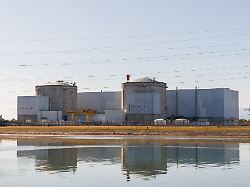Worldwide shortage
Uranium price continues to rise – no end in sight yet
January 15, 2024, 5:46 p.m
Bottlenecks are ruining the goals of one of the world’s largest uranium producers. Other companies are also not expanding production or are even stopping it completely. But because demand tends to increase, the raw material becomes more expensive. The price has now risen to a 16-year high.
The price of uranium has risen to its highest level in 16 years. Previously, one of the world’s largest producers said it was unlikely to meet its 2024 production targets. This makes the already scarce supply even smaller. On Friday, Kazakhstan’s state-owned Kazatomprom warned that it would probably produce less uranium than planned in the next two years. The company cited a shortage of sulfuric acid as the reason. In addition, the completion of new depots is being delayed.
The price of uranium is currently rising by 6.7 percent to $104 per pound. Since the beginning of the year, the price increase has totaled 14 percent. And it could go even higher if US President Joe Biden signs a law passed by the US Congress in December banning uranium imports from Russia. As short-term momentum continues to support the price, the all-time high of $136 per pound seen in June 2007 could be exceeded, say Jefferies analysts.
With Kazatomprom’s warning, the supply situation is getting even worse. In September, the Canadian uranium mining company Cameco lowered its production targets and the French Orano stopped mining in Niger. At that time, Kazatomprom had increased its production targets for 2025 with the aim of benefiting from increasing global demand. This has now been conceded again.
Acceptance of nuclear power is increasing widely
When cutting its production targets, Cameco, in turn, said that demand for uranium was “stronger and more lasting than ever” and noted that missing the targets underlined the risk of supply bottlenecks.
In fact, demand for uranium, which is used in nuclear power plants among other things, has increased as a result of the move away from carbon-emitting fuels. Acceptance of nuclear power is increasing (again) as a solution to the twin problems of decarbonization and energy security, the Bank of America noted in September.
In line with this, at the COP28 climate conference in Dubai, 22 countries signed a commitment to triple nuclear power capacity by 2050. This shows the changed attitude towards nuclear energy; According to Jefferies analysts, such statements would not have been possible a few years ago.
